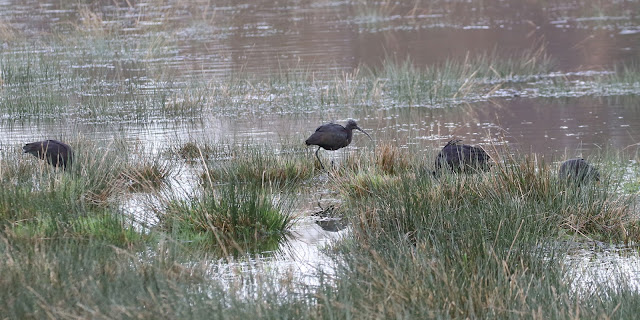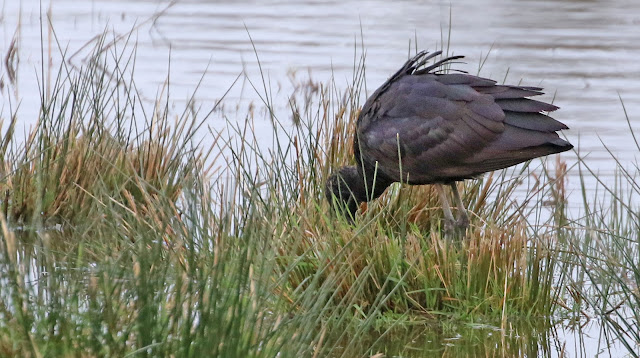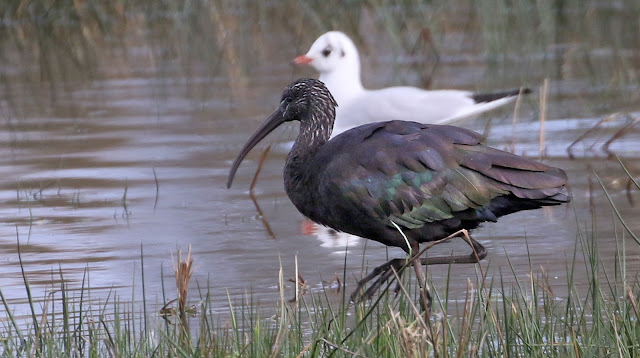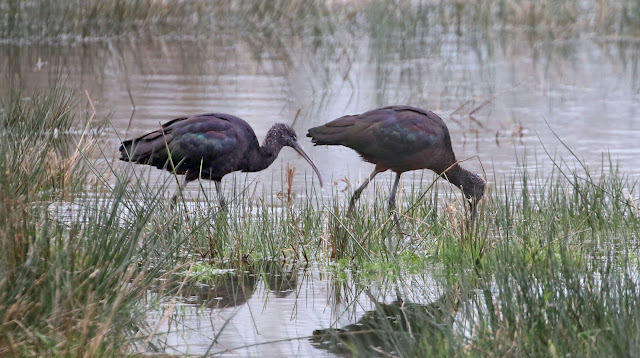On leaving Southmoor I decided to try and find the Cattle Egrets around the fields at Warblington, but as I drove down Church Lane it was clearly very busy and all the local lanes and paths were very muddy. I managed to park and walked around looking for cattle but aside from a huge flock of Brent Geese feeding in one field I could not find anything. Not wanting to waste time I decided to head for Bridge Street in Titchfield and to walk the Canal Path from the top end, there was the opportunity for one or two year ticks.
I left Warblington in sunshine but as I approached Titchfield the clouds were gathering. I managed to get a parking spot and setting off the view across both the Bridge Street and Posbrook floods was completely different to that I experienced in October, it was a case of water everywhere, with the canal it self spilling out on to the path and then across the fields.
It being January I had to stop and scan across the field to the split tree, however the Barn Owl was being rather elusive and I could only just make it out at the back of the hole.
With the sunshine now gone, it would appear that the owls had decided to move out of the light. There will be plenty of other times, no doubt.
I walked on, in places the water from the canal was breaching the bank and flowing over the path, I wasn't intending to go beyond the tarmac path, I was sure it would be either flooded or very muddy, but still people passed me walking in nice brand new white trainers!
On reaching the bridge, a scan across the Posbrook Floods produced good numbers of Wigeon, Pintail and Shoveler, I could also see Teal and a few Gadwall. I could also hear the chattering of the Black-tailed Godwits and could just make them out feeding in the shallow water close to the trees. I was looking for the Four Glossy Ibis that appear to have moved now from their travels between the Haven and Warsash and have become regular on both the Bridge Street and Posbrook Floods.
About 400 metres from the bridge there was a few people looking into the flood and on reaching them I could see the Ibis about 20 metres from the path actively feeding in amongst the grass and bulrushes.
The sun was now obscured by the clouds, but because the Ibis were close you could see the iridescence in the feathers that give them the name "Glossy".
The chattering from the Black-tailed Godwits was constant, but suddenly the volume increased and then the whirr of wings and the godwits were flying around the floods.
The Glossy Ibis (Plegadis falcnellus) is a member of the
Spoonbill and Ibis family Threskiornithidae.
The scientific name derives from the ancient Greek plegados and latin
falcis meaning sickle, referring to the distinctive shape of the bill
As can be seen at a distance, Glossy Ibises look uniformly dark, but a close look in good light reveals the stunning colours: deep maroon, emerald, bronze, and violet.
This is the most widespread ibis species, breeding in
scattered sites in warm regions
of Europe, Asia, Africa, Australia, and
the Atlantic and Caribbean regions of the Americas. It
is thought to have originated in the Old World and spread naturally
from Africa to northern South America in the 19th century, from where
it spread to North America. This species is migratory; most
European birds winter in Africa, birds from other populations may disperse
widely outside the breeding season. While generally declining in Europe, it has
recently established a breeding colony in southern Spain, and there
appears to be a growing trend for the Spanish birds to winter
in Britain and Ireland, with at least 22 sightings in 2010. In 2014, a pair attempted to breed
in Lincolnshire, the first such attempt in Britain. Since then the arrivals have increased with
double figure groups seen in southern England, it can’t be long until breeding
is confirmed, it could possible be from these four.
Glossy Ibises forage in relatively open freshwater marshes
but also frequent brackish and saltwater marshes, mudflats, mangrove swamps,
wet agricultural fields, lake or pond edges, sewage treatment areas, and
shallow rivers. Even pastures, ploughed fields, and highway margins that have
soil moist enough to permit probing for earthworms, grubs, and other
invertebrates attract ibises. Less often, they forage in dry fields, where they
eat insects or grain, such as rice. They nest in shrubs, trees, or marsh
vegetation, sometimes far from foraging areas.
Glossy Ibises are able to forage both by sight and touch.
When on dry land pursuing insects or eating grain, they pick and glean food
items. They readily consume crops such as rice and sorghum. When in wetlands or
wet soil, they use their long bills to probe into the substrate, or sometimes
swing the bill, scythe like, through water or mud, feeling for prey. They eat
a remarkable variety of creatures: leeches, earthworms, marine worms,
dragonflies, crickets, grasshoppers, many species of beetles, soldier flies,
crabs, shrimp, crayfish, molluscs, snails, fish, frogs, toads, newts,
salamanders, snakes, and lizards. Flocks of Glossy Ibis forage quite close
together, advancing slowly as they probe a muddy area.
Glossy Ibises are highly gregarious throughout their lives, feeding and resting in flocks and nesting in tight colonies where nests are usually no more than 2 feet apart. Pairs defend the immediate vicinity of their nest, attacking other ibises or herons that come too close, but otherwise are rarely aggressive. Courting Glossy Ibises bow to one another, preen each other (a behaviour called allopreening), and touch their bills together, rattling them quickly while cooing—typically in the vicinity of the nest itself. Glossy Ibises fly in flocks that resemble those of cormorants, for which they can be mistaken at a distance. Ibises tend to glide more between bouts of flapping than cormorants do.





































No comments:
Post a Comment